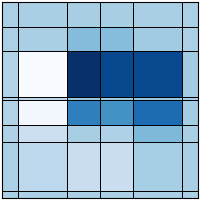Note
Go to the end to download the full example code.
2D Histogram¶
Histogram on a regular two-dimensional grid.
The x-axis and y-axis define the bin edges. As illustrated in this example, the bin widths are not necessarily identical.
@NX_class = "NXroot"
@default = "scan1"
scan1:
@NX_class = "NXentry"
@default = "data"
data:
@NX_class = "NXdata"
@axes = ["y", "x"]
@signal = "z"
x: NX_FLOAT64[7]
y: NX_FLOAT64[9]
z: NX_FLOAT64[8,6]
Explanation:
@axeshas two values which corresponds to the signal rank of two.zis the default signal to be plotted versusxandy.zhas 6 rows and 8 columns.yhas one more value than the first dimension ofzsince it contains the bin edges.xhas one more value than the second dimension ofzsince it contains the bin edges.

# Data
import numpy as np
x = [-3.0, -2.5, -1.0, 0.0, 1.0, 2.5, 3.0]
y = [-3.0, -2.8, -1.3, -0.75, 0.0, 0.1, 1.5, 2.25, 3.0]
xx = np.linspace(-3, 3, 200)
yy = np.linspace(-3, 3, 200)
xx, yy = np.meshgrid(xx, yy)
zz = (1 - xx / 2 + xx**5 + yy**3) * np.exp(-(xx**2) - yy**2)
z, _, _ = np.histogram2d(yy.flatten(), xx.flatten(), bins=[y, x], weights=zz.flatten())
# Plot
import matplotlib.pyplot as plt # noqa E402
plt.style.use("_mpl-gallery-nogrid")
fig, ax = plt.subplots()
mesh = ax.pcolormesh(x, y, z, edgecolor="k", linewidth=0.7, shading="flat")
plt.show()
Total running time of the script: (0 minutes 0.084 seconds)
